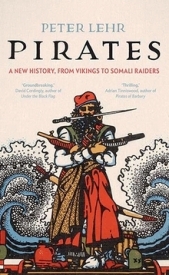 Pirates and Privateers Pirates and Privateers
The History of Maritime
Piracy
Cindy Vallar, Editor
& Reviewer
P.O. Box 425,
Keller, TX 76244-0425
    
Books for
Adults ~ History: Piracy

Pirates: A New History, From
Vikings to Somali Raiders
by Peter Lehr
Yale, 2019, ISBN 978-0-300-18074-9, US $30.00 / UK
£20.00
    
In 1998,
pirates board the MV Cheung Son. They
blindfold the twenty-three crew members, injure or
kill them, and toss them overboard. This isn’t an
isolated event, but few people know of these
incidents of piracy until November 2005 when Somali
pirates try to take a cruise ship carrying more than
300 passengers and crew. Since then, incidents of
piracy have risen and more and more people outside
the maritime world have taken notice. With this
“sudden” return of pirates comes a commensurate
number of studies on piracy and pirate history, so
why do we need still another one? For the most part,
previous titles focus on a particular time period
and/or a specific region. Such studies leave a
series of unanswered questions, which Lehr attempts
to answer:
- Is what motivates
certain individuals to become pirates today the
same as in the past?
- How do the
activities of modern pirates compare to those of
earlier epochs?
- Are there any
lessons that could be learned from historical
attempts to curb piracy which could help us end
it today?
- If naval power is
greater today than ever before, why have we not
yet been able to put an end to piracy once and
for all?
- Why does piracy
persist, seemingly against all odds? (7)
He separates the book
into three periods of history and within each of
these he examines three maritime regions. The latter
is comprised of the Mediterranean, Northern seas,
and Eastern seas. The former consists of 700-1500,
1500-1914, and 1914-today. Why these particular
divisions? The first is a time when the geographical
regions are separate and distinct and each area is
isolated from the others. The second time period
witnesses the rise of Western nations and the spread
of their sphere of influence over the powerhouses of
the previous period (the Ottoman Empire, Mughal
India, and Qing China). By the start of the next
time frame, Europe controls 84% of land in the
world, and from 1914 onward the interconnections
between nations become global. Throughout these
chronological divisions, Lehr examines piratical
commonalities and differences between the diverse
pirate cultures.
The narrative is both enlightening and enthralling.
The further one reads, the more one discovers that
there are distinct similarities between the regions
throughout time, even though the pirates of one
region had no contact with pirates of another.
Regardless of the time period, two factors motivate
people to pursue piracy: greed or grievances. As
Lehr shows, other components enhance or detract from
these since nothing is as simple or black-and-white
as it first seems. Religion and politics also play
roles, for without corruption there will be no safe
havens for pirates. Not only does he explore various
aspects of becoming a pirate and being a pirate, he
also discusses attempts to thwart or end piracy.
Regional maps introduce each of the time periods.
Illustrations of vessels are scattered through the
book, which also contains color and
black-&-white plates in the center. As the
narrative progresses, Lehr includes page references
to events discussed earlier in greater detail. A
glossary, endnotes, a bibliography, and an index are
also included.
Most readers will be familiar with some of the
pirates mentioned – Stede Bonnet, Bartholomew
Roberts, Zheng Yi Sao, and John Ward, for example –
while others are less well-known, such as Don Pero
Niño, Martin Wintergerst, and Iranun and Malay
pirates. Louis Le Golif is cited several times,
although no mention is made that there is some
question as to whether or not he actually existed.
According to Lehr, Bartholomew Roberts dies in a
shipwreck; his actual demise occurs when he was
fatally wounded in battle with the Royal Navy.
If there is a weakness in this book, it comes in the
third part of the book. Although there are a few
examples of piracy in the early years of the 20th
century, the main focus is on Somali and Nigerian
piracy. This leaves a gap in the historical
comparison.
Regardless of whether readers are well-versed in
pirate history or are novices when it comes to
pirates, Pirates is a thought-provoking and
insightful examination of piracy throughout history
and around the world. Everyone who ventures to delve
into this analysis will learn something new and will
come away with a much better understanding about who
the pirates were/are, why they turned to piracy, and
why they are so difficult to completely eradicate.
Review
Copyright ©2019 Cindy
Vallar

Click to contact me
Background image compliments
of Anke's Graphics |

